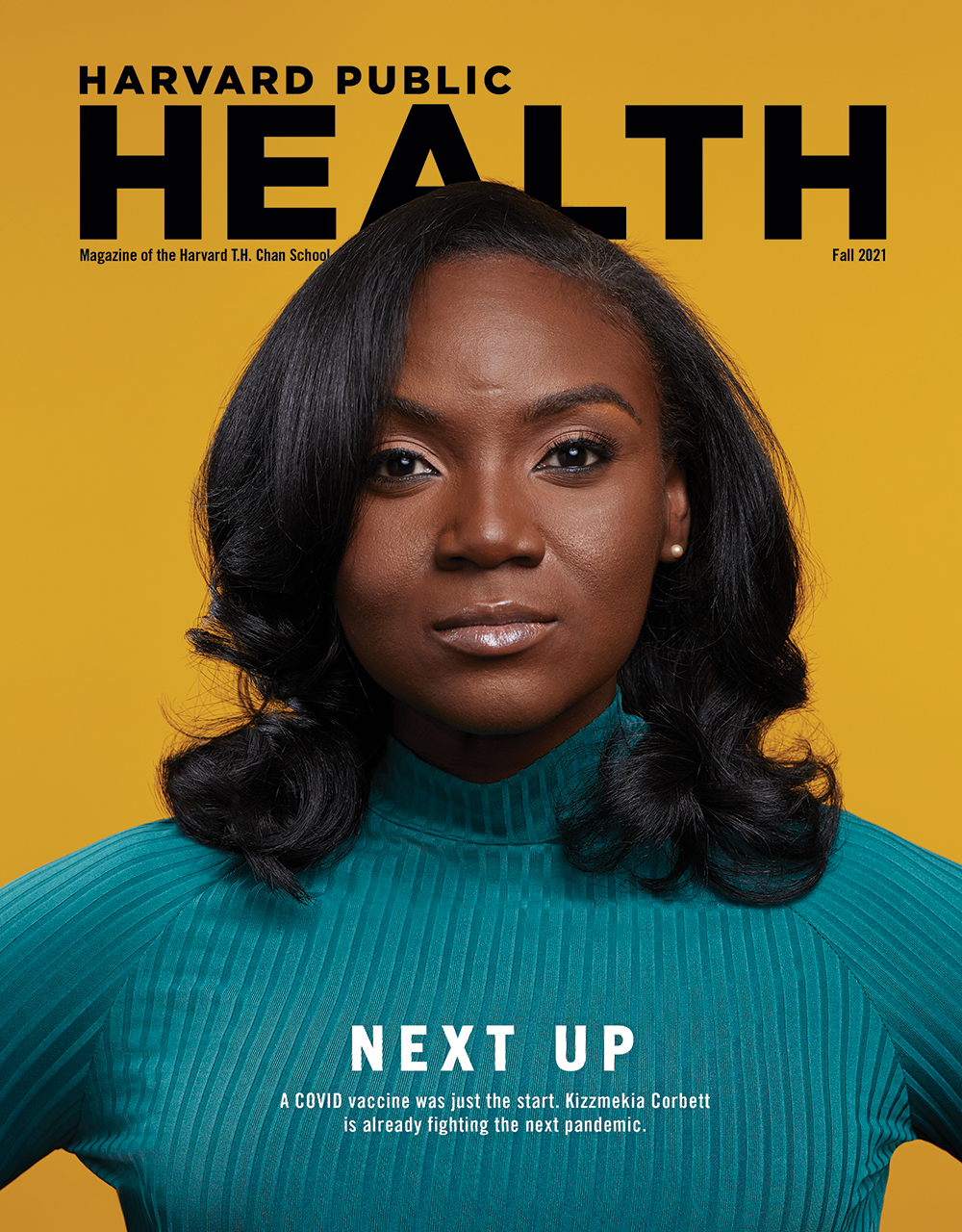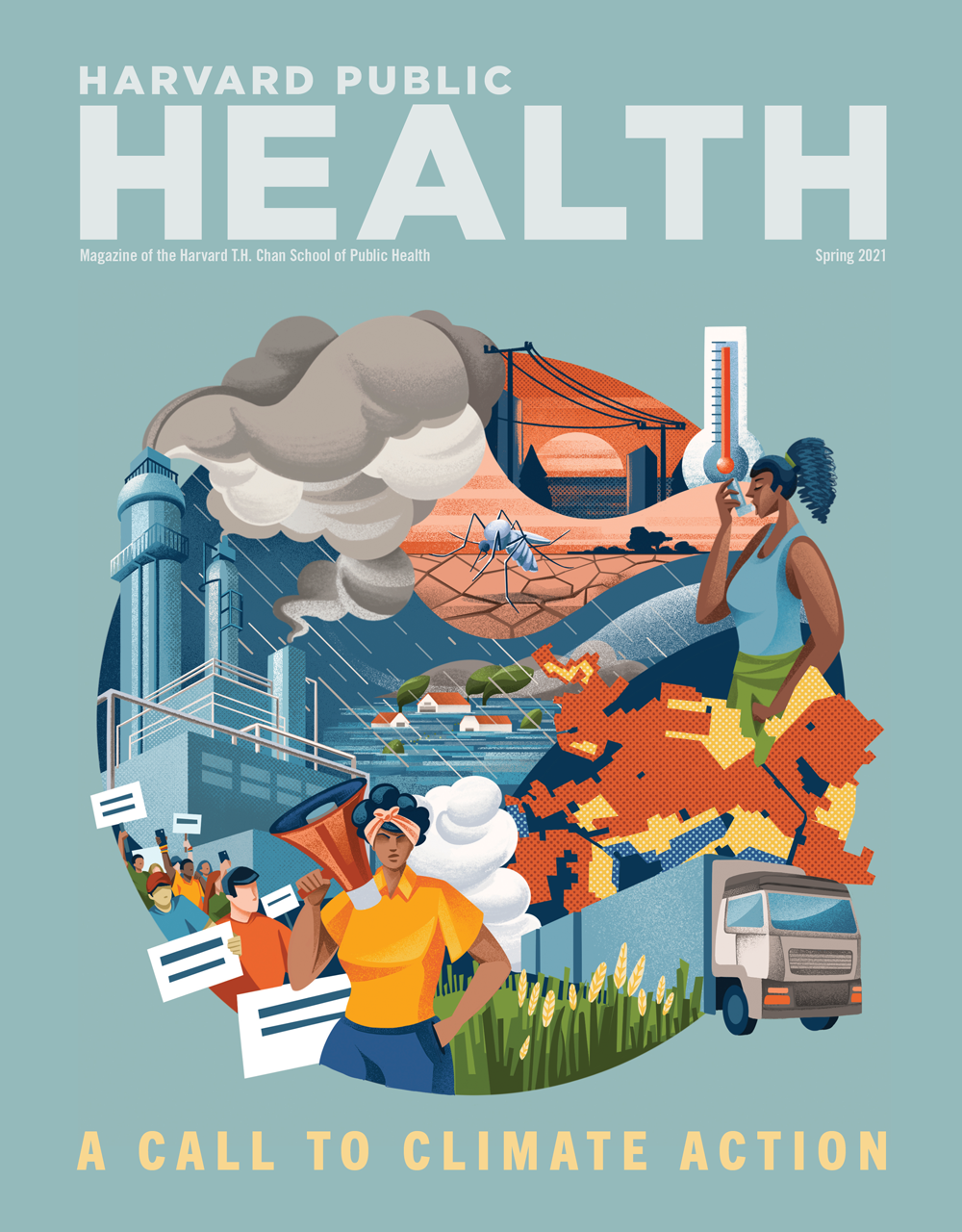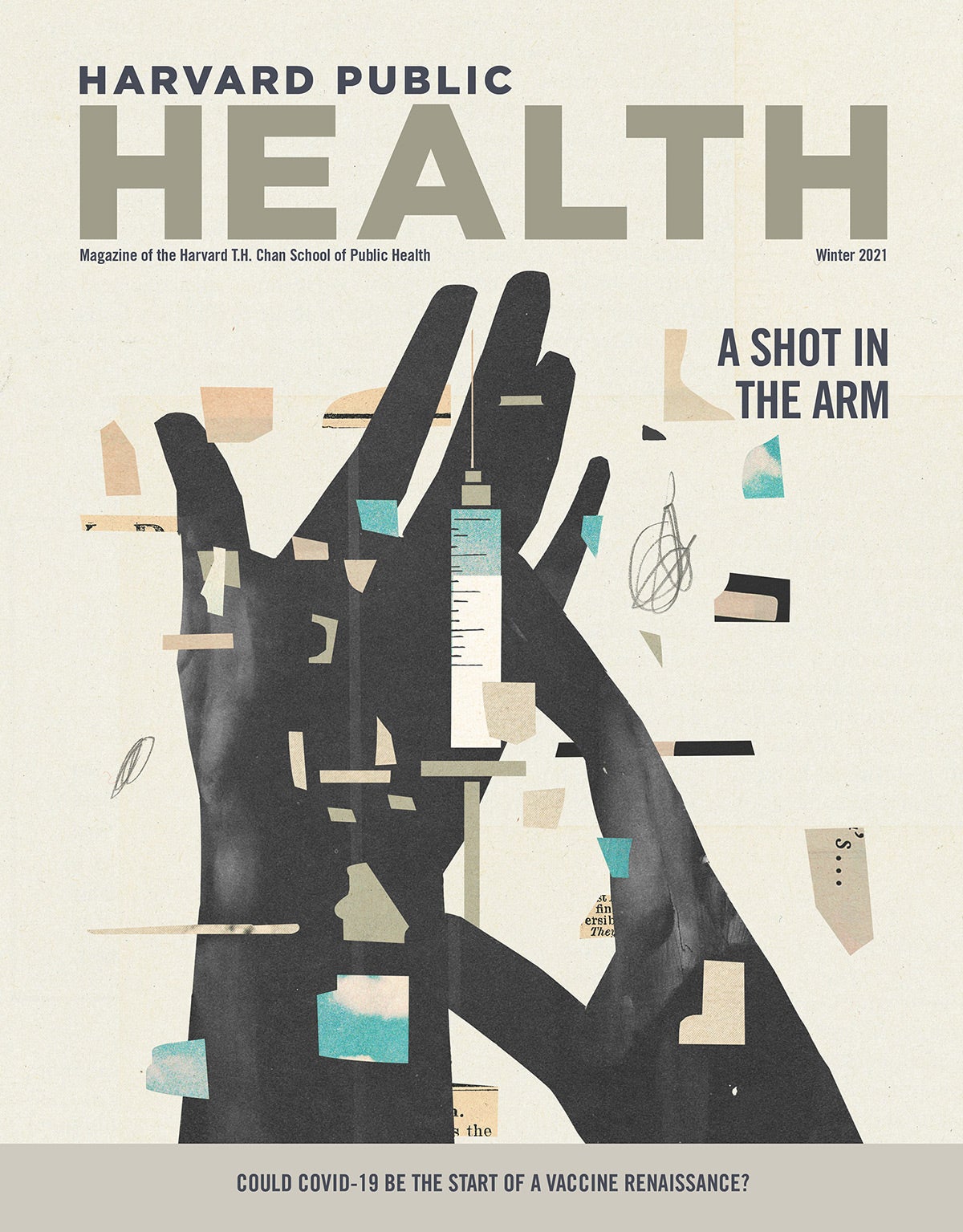
by Madeline Drexler
Spring 2020
It has been stigmatized across cultures and religions. It has been euphemized and satirized, hidden and shamed. It has also been used to exclude women from participating as subjects in modern medical research.
Now comes the reckoning. The Apple Women’s Health Study—a unique partnership among Apple Inc., the Harvard T.H. Chan School of Public Health, and the National Institutes of Health (NIH)—has set out to demystify and illuminate menstruation and accord it the scientific scrutiny and social acceptance it deserves.
Sponsored by Apple, this first-of-its-kind study will be helmed by three principal investigators (PIs) from the Harvard Chan School, joined by researchers from the National Institute of Environmental Health Sciences (NIEHS). With the potential to become the largest and longest-running longitudinal study on women’s health, it will not only shed light on the relationship between menstrual cycles, health, and lifestyle but also help refine early screening and risk assessment of gynecological conditions and other diseases. In addition, Apple will use the study’s findings to develop new health-related products.
With women making up half the human population, “the study is long overdue,” says Dean Michelle A. Williams, SM ’88, ScD ’91, a reproductive epidemiologist and one of the study’s PIs. “It was only in 1993 that the U.S. Congress mandated that women and people of color be included in government-funded clinical research. Even more startling, it wasn’t until 2014 that NIH decided to address the over- reliance on male cells and animals in preclinical research.”
Scientists had traditionally assumed that the hormonal changes associated with menstrual cycles would complicate medical studies or skew data. That exclusion from clinical trials has meant gaps in knowledge about how gender and hormonal differences may affect diagnosis, management, and treatment of disease, especially chronic conditions.
“Medical research for women has been an area that has been completely underserved. And it’s only very recently that we have equal parity in research studies of women,” says Sumbul Desai, Apple’s vice president of health. To remedy the situation, the company has focused on areas where “we can provide the information to users so they can be more proactive and engage earlier on with a physician.”
Joining Williams as PIs are Russ Hauser, MPH ’90, ScD ’94, chair of the Department of Environmental Health and the Frederick Lee Hisaw Professor of Reproductive Physiology; and Brent Coull, associate chair of the Department of Biostatistics and professor of biostatistics. Other Harvard Chan School investigators include Shruthi Mahalingaiah, assistant professor of environmental, reproductive, and women’s health, and JP Onnela, associate professor of biostatistics and director of the master of science in health data science program.
The Apple study’s main objective is to comprehensively describe the menstrual cycle. Researchers will gather information on cycle length and period length and also assess how to predict menstruation, menstrual symptoms, and the window of fertility during ovulation, when an egg is released from the ovary. The study’s findings may also lead to early clues about a range of conditions that afflict women, including polycystic ovarian syndrome (a hormonal disorder), endometriosis, premenstrual dysphoric disorder, migraine, infertility, and endocrine diseases.
The first phase of the study will target participants 18 years of age or older residing in the U.S. who have ever menstruated and have an iPhone and have downloaded Apple’s Research app to enable secure data collection. (See below: How to Enroll in the Apple Women’s Health Study.) Subsequent phases extending over many years will expand to adolescents and to volunteers across the globe.
“Major endocrine changes take place throughout a woman’s life—from puberty to pregnancy to menopause,” says Williams. “The Apple Women’s Health Study will deepen our understanding of how sociodemographic, lifestyle, biomedical, and environmental factors impact menstrual cycles and gynecologic conditions in a modern cohort of women from across the nation and of diverse backgrounds.”
A wealth of data
Smartphones can register moment-by-moment information about users’ physical activity, social support, and sleep, all of which have traditionally been studied either using self-reports or through measurements in an artificial laboratory setting. In the Apple study, most of the study data will be unobtrusively collected through iPhone sensors, such as the phone’s gyroscope (which registers angular velocity) and accelerometer (which measures linear acceleration), both of which reflect the user’s mobility and physical activity. After participants consent to providing the data to the study—which will not be marked with any contact details or other identifying information—that passively collected data will make up the vast majority of information for analysis. In his previous studies using smartphones, Onnela has generally amassed 500 megabytes to 1 gigabyte of data per subject per month; more than 99.9 percent of this data was passively collected, and the Apple study is likely to be in line with these proportions.
The Apple study will also allow participants to actively answer survey questions about age, race or ethnicity, sex, gender identity, zip code, socioeconomic status, and tobacco or alcohol usage, as well as menstrual status, health behaviors, and medical history. A monthly questionnaire will ask about hormone use and reproductive status, pregnancy update, and breastfeeding. Lifestyle surveys will collect information on sleep, activity, nutrition, and stress. The study will use a cycle tracking app to chart period days and menstrual symptoms. All participants have control over the type of data shared with the study, and any data collected will be encrypted if participants have a passcode set on their device. Once shared, it is stored securely in a system within Apple that is designed to meet the technical safeguard requirements of the HIPPA Act.
A study of this scale and scope is made possible by the extraordinary adoption of smartphones, with 5.7 billion subscribers—70 percent of the global population—expected by 2023, according to Cisco’s 2020 Annual Internet Report White Paper. In the U.S., rates are even higher, approaching 90 percent. “Ten years ago, almost nobody had smartphones,” says Onnela. “I cannot think of a single technology that has gone from zero to nearly 90 percent adoption in the span of a decade. This did not happen for laptops, computers, televisions, or cars.”
Globally, women of reproductive age have avidly deployed smartphones to track their periods. According to a January 2019 story in Bloomberg News, more than 100 million women around the world use free menstruation-tracking apps, with such names as Flo, Glow, Ovia, and Clue. Some rely on the apps to help them get pregnant or avoid pregnancy, while others use them to better understand how their bodies are functioning.
Menstruation as a vital sign
In recent years, researchers have acknowledged the need to reevaluate the relationship of menstruation to overall health. Treating the menstrual cycle as a vital sign—comparable to blood pressure, temperature, pulse rate, and respiration rate—could lead to earlier detection of many conditions, both gynecological (such as fibroid tumors) and systemic (such as diabetes).
Likewise, tracking lifestyle changes among those who menstruate—including the effects of body composition, activity levels, increased life expectancy, and postponement of childbearing—could help scientists glean factors that make an impact on menses.
“The menstrual cycle is an indicator of whole-body health at the level of the brain, the endocrine system, and the ovaries,” explains Mahalingaiah. “It tells you, in a very general sense, that your brain, hypothalamus, pituitary gland, and ovaries are communicating well and that your thyroid is in balance. This doesn’t necessarily mean that having a period gives you a clean bill of health. But ovulation is like the flower on top of the plant. A female organism needs to be healthy in order to ovulate.”
A window on women’s health
The first modern study of menstruation was the Tremin Research Program on Women’s Health, launched in 1934. Housed at the University of Minnesota, Tremin was an observational study that collected menstrual diaries on nearly 2,000 women for up to 42 years. Although its findings challenged the conventional wisdom that regular, 28-day cycles were the norm that defined good health, it left many questions unanswered.
“We’ve long had the idea that menstrual cycles are a window on women’s health,” says Allen Wilcox, a reproductive epidemiologist and scientist emeritus at NIEHS, who is part of the Apple study team. “But what does that really mean? How does the menstrual cycle predict future health outcomes?” Female hormones have been linked to myriad diseases, from cancer to cardiovascular disease to osteoporosis. “It’s hard to think of an illness that potentially isn’t related to a woman’s reproductive life,” says Wilcox.
The Apple study could also illuminate more elusive diseases that strike women. “Conditions such as endometriosis and polycystic ovary disease are not rare in women, but they are extremely difficult to study because they’re internal, and they manifest as symptoms and signs that are not very specific. It’s often hard for women to get diagnosed, especially if they have mild cases,” says Wilcox. “I would hope that, in the course of the Apple study, we might get more information about women who are ultimately diagnosed with these diseases and then look back to see if there were early clues in their menstrual cycles.”
Menstrual cycles are also inextricably linked to other reproductive events, such as ovulation and overall fertility. “When we get into fertility issues, it’s a wide-open game,” says Wilcox. “Epidemiology has been studying fertility in an intentional way only for the last three decades. There’s so much to learn about factors that might influence a couple’s fertility, including clinical conditions and environmental exposures.”
Eventually, the Apple study could help predict risk for the major-disease killers late in life, such as heart disease and breast cancer. “I also conduct a lot of research on male reproductive health,” says Hauser. “And there’s a developing science showing that men with poor semen quality have a greater risk of morbidity and mortality decades later. The question is: Is there a direct connection between having poor semen quality and having a greater risk of metabolic or cardiovascular disease 20 to 40 years later? By analogy, studying the menstrual cycle and other female reproductive health conditions over a long period of follow-up may help predict later risk of disease and ultimately lead to medical screening, interventions, and treatment.”
The Apple study could even demolish myths surrounding menstruation. Recent studies have found, for example, that female athletes actually perform better during their bleeding days, perhaps because estrogen and progesterone levels are at their lowest, which diminishes their physiological impact. “The more that we can help women understand those kinds of effects and how they might be predictable from cycle to cycle, the better,” says Wilcox.
Cutting-edge innovation
Virtually every aspect of the Apple study breaks new ground. With an intention to follow women across the life course, the study will have the power to detect very small effects of behavior and lifestyle on reproductive health, as well as rare conditions that strike relatively few women.
“The important thing about menstrual cycles is not just the onset of bleeding and the length of bleeding but also the pattern over time,” says Wilcox. “That’s very hard for a woman to report accurately, obviously. The only way to understand menstrual patterns and how they relate to health is by collecting data over a long time span.”
The breadth of the Apple study also means it will capture the experiences of women who until now were not adequately represented in clinical research. “What’s compelling is that the study will use a device and platform that could reach huge proportions of the population, people whom we haven’t been able to access before using traditional methods. It will track individuals who are remote from academic centers or city centers, either at a university or a hospital, where previous research had been conducted,” says Mahalingaiah. “That means the results will be more generalizable to the broader population.”
By leveraging smartphone technology, study data will also be more reliable than surveys and self-reports, which are often tainted by recall bias. “As smartphones become more sophisticated, it creates opportunities to measure, in real-world settings outside of research labs, how people actually behave,” says Onnela.
Having led smartphone-based studies on conditions ranging from stroke and brain tumors to schizophrenia and depression, Onnela is a leader in the field of “digital phenotyping,” which he defines as the “moment-by-moment quantification of the individual-level human phenotype in situ using data from personal digital devices,” smartphones in particular. “In the past, it’s been very difficult to quantify behavioral factors,” he says. “With data from smartphones and wearable devices, we can measure these factors unobtrusively over long periods of time.”
The Apple study grew out of a unique convergence of institutional interests. In a January 2019 interview with CNBC, Apple CEO Tim Cook declared, “If you zoom out into the future, and you look back, and you ask the question, ‘What was Apple’s greatest contribution to mankind?’ it will be about health.” In addition to the women’s health study, Apple has launched two others: on hearing and on mobility and heart health, all available for voluntary participation on Apple’s Research app. Notes Apple’s Desai, “Apple selected Harvard and NIEHS as data collaborators based on their scientific expertise, academic excellence, and commitment to publishing. As our data collaborators analyze the data, they will be making it public as soon as they can, so as to advance generalizable knowledge and science.”
The company’s aspirations dovetailed with Williams’. “Two things propelled me to this opportunity,” she says. “First, as a reproductive epidemiologist, I know firsthand [what] the scientific and intellectual opportunity a study of this scope and scale means to the field and to women’s health.
“Second, as a leader in academic public health, I appreciated that a collaboration involving academia, NIEHS, and Apple would lead others to think creatively about partnering across sectors to drive resources and talent into biomedical research and public health challenges. The opportunity fits squarely within my vision for the School—that is, to keep finding new partners to join public health scholars and practitioners in making the world a more just and healthy place.”
The Apple study convenes three players outstanding in their respective domains. “To my mind, this study represents the future of public health: a three-way partnership between academia, industry, and government,” says Williams. “By partnering and bringing our respective assets—and they are formidable—to the table, we will make far more progress than if we were to keep operating in our increasingly siloed environments.”
Each member of the triad has singular strengths. As PI Brent Coull puts it: “The group from our School has expertise in women’s reproductive health, including fertility, clinical translation, menstrual tracking apps, epidemiologic methods, and decades of rigorous work in large cohort studies. JP Onnela and myself bring expertise in data science and biostatistics—managing and analyzing complex longitudinal data. NIEHS has done foundational work in ovulation, fertility, and women’s health as well and is strong in epidemiologic methods. And Apple obviously brings expertise in technology, data collection, and secure data storage. They also have the reach to the population under study. If we weren’t using mobile devices—iPhones and Apple Watches—it would be extremely hard to recruit a cohort of this size.”
Recruit and retain
Inevitably, a study of this scope faces hurdles. Perhaps the biggest challenge will be recruiting enough women and ensuring that they stay enrolled. “It’s important that large numbers of people join the study, but it’s also important that they stay in the study for as long as possible,” says Onnela.
Recruitment in general for clinical studies has become more difficult in recent decades. “Part of it has to do with trust,” says Hauser. “If you go back 20 years, recruitment was by mail or phone call or flyer. Nowadays, people are bombarded with advertisements, whether through the internet or their phone. They are weary.”
Concerns about privacy and confidentiality may also deter some women. “Privacy is always a concern when we do research in health,” says Onnela. “I’m someone who’s been using cell phone data to study human behavior for the past 15 years, and I’m very impressed with Apple’s commitment to privacy.” Adds Wilcox: “Our group has felt confident enough about Apple’s intentions that we have thrown ourselves into this collaboration. Apple is doing everything humanly possible to try and make sure that participants are protected.”
According to Desai, “As one of its core values, Apple believes that privacy is a fundamental human right. Therefore, privacy is built into all products and services from the beginning. The Research app was carefully created to only share data with the chosen studies when the user approves. It also includes a clear enrollment flow with detailed consent that explains how data will be used and allows a user to control the type of data shared with each study. Apple will not have access to any contact information or other identifying data that participants provide through the Research app.”
Although Apple’s iOS software has unparalleled reach, its user demographics do not precisely mirror the country’s. “People who have iPhones, as opposed to Android phones, tend to be higher up on the socioeconomic status ladder and tend to have higher incomes, on average. This is something that we can and will adjust for,” says Onnela. He adds: “I always emphasize that there is no such thing as a perfect study. There never has been one and likely there won’t be one. The goal is to try to improve on what we’ve done in the past.”
With such concerns hovering over the recruitment process, study leaders are banking on participants’ sense of altruism to make the project a success. Participants will not be compensated in any way—other than with the knowledge that the study’s findings will help women in the future.
“There’s no monetary gain,” says Mahalingaiah. “The way that I can inspire women is to say that the study will contribute to discovery in women’s health, that we can improve and elevate health and wellness for all women. And if a woman is healthy, the people around her will be healthier, too.”
Promoting citizen-scientists
If successful, the Apple study could generate new templates for prospective large-scale studies using smartphone technology. “I’m optimistic that by sharing lessons learned, we will spark many others to build upon and improve the model,” says Williams. But she sees the benefits reaching even further. “Most compelling for me is that the study will promote a generation of citizen-scientists: girls and women with increased knowledge and awareness of their own menstrual experience and health, knowledge that they can use to better manage, protect, promote, and preserve their own health and wellness.”
In casting its net wide, the Apple study will also go a long way to demystify and destigmatize menstruation. “Across the board, there is a stigma around menstrual health, menstrual disorders, menstrual pain and bleeding,” says Mahalingaiah. “Anything around that aspect of health has been stigmatized for young women growing up. Many can’t even articulate what they might be experiencing.
“Having collaborators like Apple and NIEHS come together with the School to study menstruation, bringing it to a mainstream discussion platform, is really important,” she says. “No matter where the research goes, this collaboration elevates the status of the menstrual cycle. It’s an endorsement that this is an important thing to study.”
— Madeline Drexler is editor of Harvard Public Health.
How to enroll in the Apple Women’s Health Study
To enroll in the study, potential participants can download the Apple Research app from the iOS App Store onto their iPhone and complete the enrollment and consent process through the app. The Research app requires an iPhone 6s or later with iOS 13.2 or later. Apple Watches are not required, but can provide additional information, such as heart rate.
Participants will be asked to provide explicit and voluntary consent for passive collection of their health and sensor and usage data. They will also be asked to complete surveys at various frequencies, including a single time, monthly, quarterly, and annually. Women who are menstruating will be asked to track their menstrual cycles in the Health app with Cycle Tracking or any other menstrual cycle tracking app that writes data to the Health app. Participation is possible even if someone hasn’t menstruated in many years.
The study is envisioned to span decades. Participants will be asked to renew their consent to continue in the study every two years and can withdraw from the study at any time. Enrollees may continue to participate in the study even if they become pregnant, have sex-reassignment surgery, or stop menstruating.
Any information collected or accessed by the Research app will be stored with encryption if participants have a passcode on their iPhone. Study data that directly identifies participants (such as name, email address, and phone number) will be kept separate from the rest of the study data and replaced with a random code unique to each participant.







